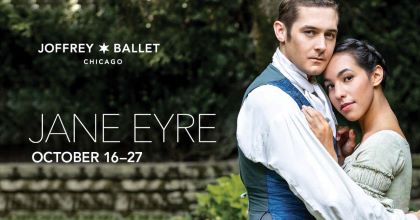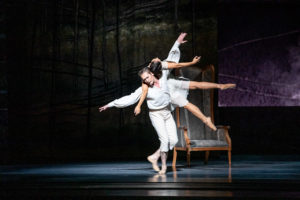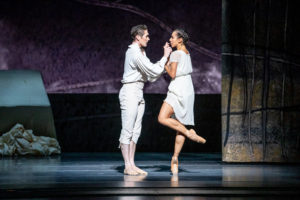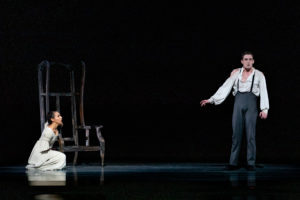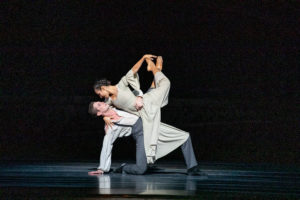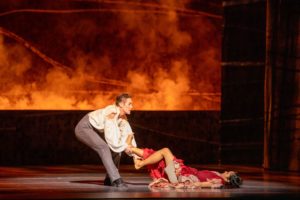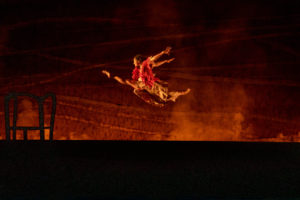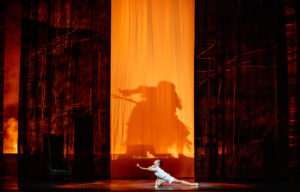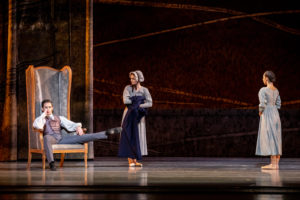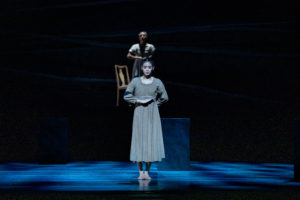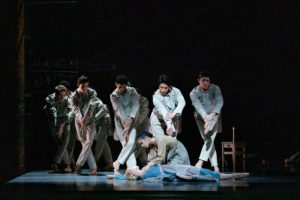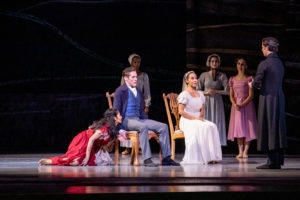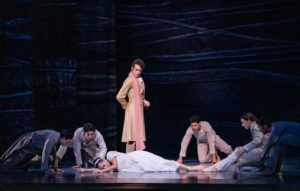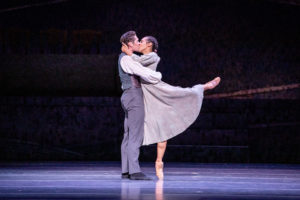DEMONS DANCE ON THE MOORS
You can’t keep a good protagonist down. A 2016 British ballet (also performed in June by American Ballet Theatre), Jane Eyre transforms a romantic heroine into a feminist icon, her sterling goodness sturdy enough for 2019.
Joffrey Ballet’s Chicago premiere of Cathy Marston’s literally moving 130-minute version reaffirms a once and future fictional breakthrough: Charlotte Brontë’s 1847 mistresspiece (strangely the original author is never mentioned in the credits) delivers a role model for today. Indeed, this vision of Brontë’s work is more faithful to the future than to the 172-year-old novel.
Our Jane is no modest, self-denying governess, patiently waiting like a Jane Austen heroine for Edward Rochester (Greig Matthews), the man she will arduously adore, to come to his senses and discover her worth. Apart from the obstacles — a fashionable rival named Blanche Ingram (Jeraldine Mendoza); Edward’s demented arsonist wife, Bertha Mason (Christine Rocas); and Jane’s abusive lover St. John Rivers (Edson Barbosa) — this Jane (a transcendent Amanda Assucena) faces her own inner demons. They’re outwardly portrayed by the so-called D-Men (standing for death and demons). Clad in sinister white frock coats, this 11-strong chorus is a misogynistic cabal of forces trying to thwart the happiness of a deserving orphan.
In Marston’s revisionist scenario, Jane and her haplessly devoted Edward, the master of Thornfield Hall, must be equalized sexually as much as socially: Edward’s tragic final blindness levels their differences, allowing her to play with and to protect him. Until then their dance duos had been tender and slow, in contrast to the overall frenetic and impulsive feel of Marston’s kinetic choreography. But in their final coupling Jane is the dominant partner, stepping alone in the limelight in a final apotheosis.
Borrowing the lush and pianistic music of the period, like Franz Schubert and John Field, composer/compiler Philip Feeney provides this ballet’s most engaging element, gorgeously performed by the Chicago Philharmonic and music director Scott Speck. Providing all the heartbreak required for a 19th-century romance, this seamless musical backdrop of melodic make-believe makes the motivations that Marston’s movements deserve.
Assucena makes a memorable Jane, equally troubled and triumphant, as this decreasingly insecure woman engages with Matthews’ ever-evolving Edward. As her younger self, Yumi Kanazawa enacts the mute anguish of invisibility during the Victorian Age. As always, the Joffrey ensemble members are precise in their passions, even in the expressionistic dream sequences: Their seemingly spontaneous steps feel orchestrated to the last emotional degree.
Also helping to put the story center stage are set and costume designer Patrick Kinmonth’s abstract illustration of the Yorkshire moors and his far from fashionable garb, lit by Brad Fields. Marston’s dance designs do the rest, depicting the inner turmoil of Brontë’s first-person narrator as fully as the many outer perils faced by an intrepid and resourceful Jane.
The program’s ballet notes may prate of Jane establishing her “agency” (a blandly functional term) over the men who oppress it. Such glib schematics may play well enough with grant proposals. But with dance the proof lies in the persuasion of one step after another leap. Happily, the Joffrey corps, now in its final season at the Auditorium Theatre before moving to Civic Opera House, remains characteristically unrivaled.
Jane Eyre
The Joffrey Ballet
Auditorium Theatre of Roosevelt University, 50 E. Ida B.Wells Drive
ends on October 27, 2019
for tickets, call 312.386.8905 or visit Joffrey
for more shows, visit Theatre in Chicago
